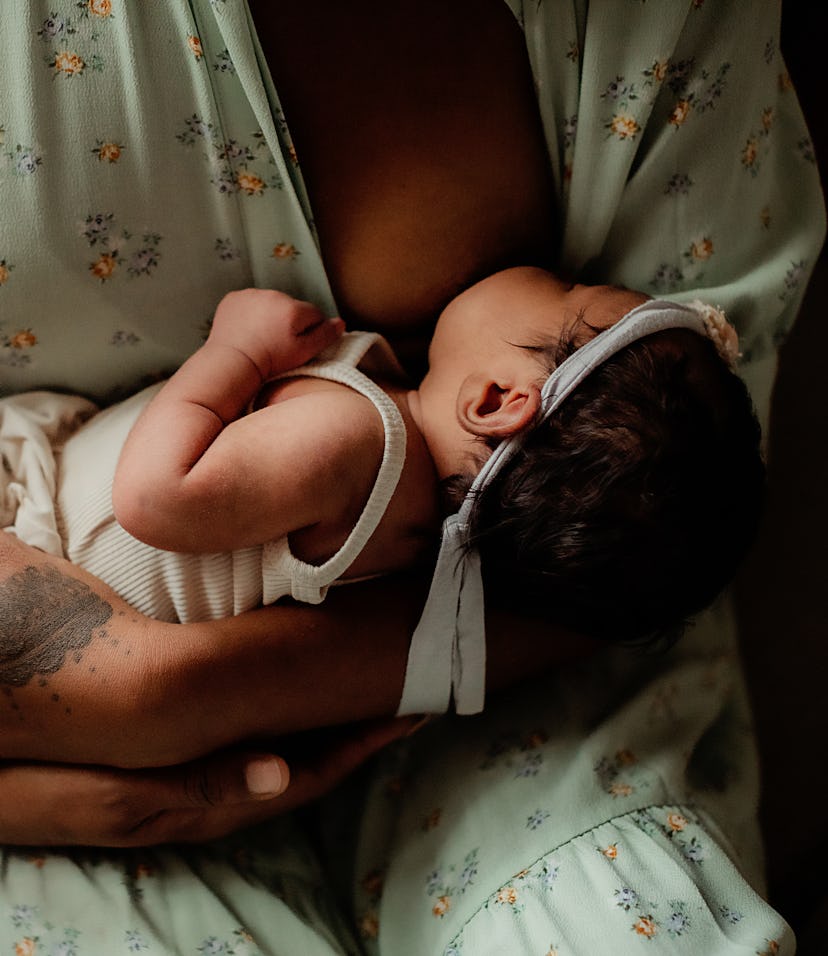Breastfeeding

Does Breastfeeding Cause Sagging?
Here’s the truth behind the boob droop.
Body changes during pregnancy are pretty much inevitable. From head-to-toe stretch marks to lost elasticity in your skin and even hair loss, it can feel like no part of your body is immune. On top of all of these changes, you might wonder how nursing will affect your breasts post-birth. Like, does breastfeeding cause sagging? Are you destined to have droopy boobs if you choose to use them to feed your baby?
Unfortunately, the answer here is a double-edged sword. While breastfeeding isn’t the sole culprit, sagging breasts can often occur after pregnancy.
What Causes Breasts To Sag After Birth?
“Although breastfeeding tends to take a good deal of blame for saggy breasts, it's not breastfeeding alone that causes the breasts to droop,” Dr. Jessica Shepherd, OB-GYN and Chief Medical Officer of Verywell Health tells Romper. “Sagging is actually the result of pregnancy and other influences.”
Among the “other influences” noted by Shepherd are aging, weight loss or gain, genetics, number of pregnancies, smoking, exercising without support, and gravity. “Breasts can change shape or volume due to many factors, it’s rarely just because of one,” Shepherd says.
After giving birth, you can actually still experience breast sagging even if you aren’t breastfeeding.
“When you're pregnant, the ligaments which support the breasts may stretch as the breasts get fuller and heavier. After pregnancy, the breasts can appear ‘saggier’ whether or not you breastfed,” Chrisie Rosenthal, IBCLC and Consultant Relations Manager at The Lactation Network, tells Romper.
Why Do Breasts Look Saggy After Breastfeeding?
If you’ve ever experienced the merry-go-round of fullness, then sag, then full again, then super saggy that is breastfeeding, it makes sense to question why your breasts look so deflated after a feed. Even though this type of sagging isn’t permanent, the process can make you feel like your breasts won’t ever be the same again.
“Your breasts appear fuller before a feed because the milk glands and ducts are full of milk. When a baby feeds, or a parent pumps, milk is removed, which makes the breast look less full and softer,” Rosenthal explains. “However, an important concept to keep in mind is that even though breasts may be more or less full throughout the day, breasts are never truly ‘empty,’ they will continue to produce milk on demand.”
When it’s time for your baby to wean, you’ll experience yet another round of changes before your boobs finally settle into their final post-breastfeeding shape, size, and appearance.
“At this point, breasts can feel less full and it could take six months or longer for your breasts to return to the way they were before you became pregnant. However, they may never be exactly the same,” Shepherd says. “After going through all the changes of pregnancy and breastfeeding, your breasts may remain larger, or they may appear smaller and softer. They may have stretch marks, or they may seem saggy. If the breast tissue shrinks down, but the skin stays stretched, the breasts will look saggy. These are all normal changes that can occur.”
Does Sagging Impact Breast Health?
None of the changes your breasts go through during pregnancy or after giving birth are indications that anything is “wrong” with your body. In fact, it’s all extremely normal and just part of the process.
But while you’re breastfeeding, it’s still a good idea to keep an eye out for anything that might be of concern. (You’re already paying close attention to your boobs, anyway, you know?)
“During breastfeeding, many people are able to find abnormal lumps in the breast and it should not cause significant concern,” Shepherd tells Romper. “It can help to perform a regular self-examination, using the hands and eyes to detect any changes or abnormalities in your breasts. If there are any areas of redness or soreness, it should be discussed with a healthcare professional.”
Experts:
Chrisie Rosenthal, IBCLC, Consultant Relations Manager at The Lactation Network
Dr. Jessica Shepherd, MD, OBGYN, Chief Medical Officer of Verywell Health